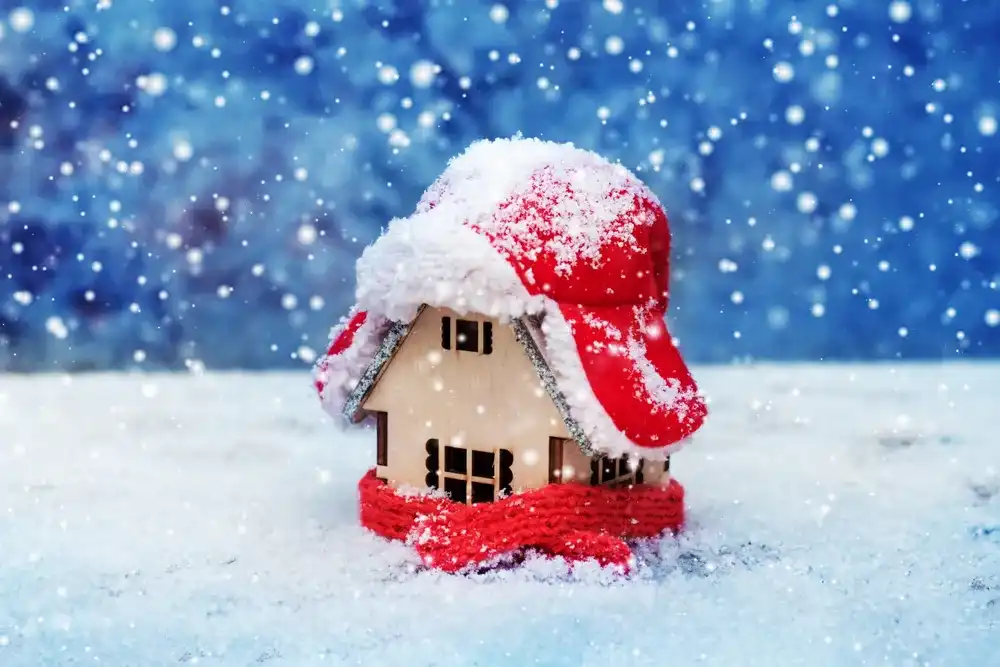Cold Weather Tips for Home: Budget-Friendly Ways to Prepare Your Space for Winter Comfort
As winter approaches, there's a glimmer of good news for your wallet: the U.S. Energy Information Administration anticipates that overall winter heating prices won't break the bank, especially for those in the western U.S. relying on natural gas.
However, while the forecast suggests a milder winter in the west compared to the icy temperatures of the previous year, the cost of keeping warm can still cause some sleepless nights. In this article, we'll explore budget-friendly strategies to prepare your home for winter, ensuring both comfort and savings.

Stay Warm Without Breaking the Bank: Inexpensive Home Preparations for Winter
In a financial landscape where 61% of Americans live paycheck to paycheck, according to a CNBC survey—an increase from 58% in March—households are acutely aware of the need to manage their expenses. Reports from LendingClub and others indicate that many have already tapped into their cash reserves in recent months.
Against this backdrop, preparing for winter takes on a new importance. With the prospect of rising heating costs, despite recent dips, making strategic and cost-effective plans for efficient energy usage becomes a high-priority item on the checklist for homeowners and renters alike. Let's explore practical and affordable ways to keep your home warm without straining your budget.
Understanding Your Home's Winter Needs
As winter approaches, homes face a unique set of challenges that can impact both comfort and budget. Being aware of these issues is the first step toward cost-effective winter preparation.
Common Winter Challenges
- Ice Dams: Ice dams form when melting snow refreezes at the edge of the roof, causing water to pool. This can lead to roof leaks and structural damage.
- Damage from Debris: Accumulated debris, such as leaves and branches, can wreak havoc on your home during winter storms, causing roof damage and potential leaks.
- Overworked Heating Systems: Continuous use of heating systems can strain them, leading to inefficiency, higher energy bills, and even system breakdowns.
- Flooding from Ice and Snow Melt: Rapid thawing of ice and snow can overwhelm drainage systems, resulting in basement flooding and water damage.
- Frozen Pipes: Subfreezing temperatures can cause pipes to freeze, leading to bursts and water damage when they thaw.
- Sewer Backups: Winter weather can increase the risk of sewer backups, causing messy and expensive problems inside your home.
Importance of Energy Efficiency
Ensuring energy efficiency is critical in preparing your home for winter. This approach offers a range of benefits. On the environmental front, heightened efficiency is crucial in diminishing greenhouse gas emissions, reducing pollutants, and conserving water resources.
Moreover, the economic advantages of improved energy efficiency extend beyond merely lowering utility bills; they encompass job creation, fostering a positive impact on employment, and contributing to stabilizing electricity prices, offering a dual benefit for both your household and the broader community.
This all said, understanding your home's winter needs is crucial in navigating the season's challenges. From preventing ice dams to ensuring energy efficiency, a proactive approach enhances comfort and safeguards your budget and the environment. Stay tuned as we explore practical and budget-friendly solutions to address these concerns in the upcoming sections.
Insulation on a Budget
Insulation serves as a barrier to prevent heat loss or gain between the inside of your home and the external temperature. The insulation cost typically ranges from $1.00 to $4.50 per square foot, with an average house insulation cost falling between $1,600 and $8,000.
This cost includes both material (priced from $0.50 to $2.80 per square foot) and installation labor (ranging from $0.50 to $1.70 per square foot). While professional contractors can install insulation, there's also a cost-effective option: do-it-yourself insulation.
For those looking to save money, consider these DIY insulation tips for windows and doors:
- Use Weather Strips: Inexpensive strips provide a seal for doors and windows.
- Install New Door Sweeps: Block out cold air by adding a door sweep along the bottom of exterior doors.
- Apply Foam Tape: Seal gaps with foam tape.
- Insulate with Window Film: Add an extra layer to windows with insulating film.
- Hang Insulated Curtains: Thick curtains can provide additional insulation.
- Recaulk Windows and Doors: Address gaps and drafts with fresh caulk.
- Use a Door Snake: Place a draft stopper at the base of doors.
When it comes to materials, fiberglass insulation tends to be the cost-effective choice. Comprising fine glass fibers, it's available in various forms, such as blankets, loose-fill, rigid boards, and duct insulation. Retailers like Home Depot, Lowe's, and Menard's offer these insulation materials, making them accessible for budget-conscious homeowners aiming to bolster their winter defenses.
Energy-Saving Heating Solutions
Maximizing the efficiency of your existing heating system is a savvy approach to winter comfort without breaking the bank. Furnaces, particularly those powered by natural gas, stand out as one of the most efficient heating options.
Operating by heating air through a heat exchanger and distributing it with a fan through a duct system, furnaces boast high-efficiency ratings and relative affordability. New units typically cost between $2,000 and $7,000.
Despite their advantages, the downside of furnaces lies in their noise levels due to the fan. To address this, consider optimizing your furnace settings and exploring alternatives. Low-cost heating options include:
- Solar Heating: Rethink solar heating's accessibility—it's not just for eco-conscious homes with hefty budgets. Solar systems are gaining popularity and affordability, boasting a return on investment as quick as three to six years, per the Solar Energy Industries Association®. Utilizing thermal energy from the sun, these systems cut reliance on conventional fuels, curbing pollution and promoting environmental friendliness. Most setups include solar collector panels on a southern exposed wall, insulated piping, and a hot water storage tank. Besides potential energy bill savings, some states offer tax incentives for adopting solar energy systems.
- Geothermal Heating: Geothermal heat pumps outshine traditional counterparts, operating quietly and independent of external air temperature. Requiring minimal maintenance and boasting longevity, these systems harness the earth's constant temperature a few feet below the surface, ensuring energy savings despite higher initial installation costs than air-source systems.
- Hybrid Furnaces: Hybrid heating systems mainly rely on electricity but incorporate a secondary fuel source, typically natural gas, activated during peak demand. Outdoor sensors and thermostats trigger the secondary source in colder temperatures. Leveraging the cost-effectiveness of natural gas, these systems can offer lower operational expenses compared to all-electric alternatives in certain regions.
- Wood Stoves: Wood stoves provide versatile heating, serving as supplemental warmth or the main heat source for a home. Beyond being renewable, wood is often more cost-effective than gas, oil, or electricity. Adhering to EPA regulations and local codes is crucial during installation. Additionally, energy-efficient inserts can enhance existing fireplaces.
- Radiant Floor Heat: Radiant floor heating is a top choice for builders, offering energy efficiency and comfort. Its concealed installation beneath the floor or in wall/ceiling panels eliminates visual obstructions. More efficient by bypassing ductwork, it's allergen-friendly, quiet, and retrofittable for existing homes, with options like electric or hydronic systems and compatibility with programmable thermostats and solar panels.
Exploring these alternatives not only offers potential cost savings but also allows for a more personalized approach to winter warmth. Whether optimizing your existing furnace or considering these low-cost alternatives, finding the right heating solution ensures a cozy winter home without straining your budget.

Protecting Pipes from the Cold
As temperatures plummet, safeguarding your pipes from freezing becomes crucial to prevent costly damage. Start by setting home thermostats above 55 degrees during cold spells. Let cold water drip from the farthest faucet, as the movement helps prevent freezing. Identify shut-off valves for emergencies, insulate pipes in unheated areas, and open cupboards to warm pipes—close inside valves controlling water supply and open outside spigots to drain water, allowing expansion without damage.
For inexpensive insulation, foam tubing is a go-to. Available in 3/8 and 5/8-inch thicknesses with two-sided tape, the latter is ideal for colder climates. Another option is fiberglass pipe insulation, resembling attic insulation.
With foil facing, it's suitable for high-heat areas like near water heaters or furnaces. These cost-effective measures ensure your pipes withstand winter's chill without breaking the bank.

Sealing Leaks and Drafts
Chilly drafts infiltrating your home often slip through gaps and cracks around doors and windows. Identifying and sealing these drafts inexpensively can significantly improve your home's comfort. Start by visually inspecting for gaps and listen for rattles or whistling sounds, particularly in windy conditions.
Consider using a thermal detector that displays temperature differences on your walls to pinpoint drafts accurately. Alternatively, lighting an incense stick and observing its movement around potential leak sites or using a damp hand to feel for cool drafts are effective low-cost methods.
The long-term benefits of a well-sealed home extend beyond just keeping the cold out. By air sealing, you cut heating and cooling costs, enhance durability, increase comfort, and create a healthier indoor environment. Enjoying a well-sealed home translates to better sleep, reduced stress, and overall improved well-being, making the effort a worthwhile investment in your home's comfort and personal happiness.
Budget-Friendly Winter Maintenance
As winter approaches, prioritizing regular checks and maintenance tasks can help you avoid costly repairs and ensure a warm and comfortable home. Consider this budget-friendly checklist to prep your home for the colder months:
- Insulate Windows and Doors: Seal gaps and prevent drafts by adding weatherstripping or using window film.
- Inspect Fireplace Flue and Damper: Ensure your fireplace is in working order by checking the flue and damper for any obstructions.
- Swap Lightweight Curtains for Heavy Material: Upgrade to thicker curtains to provide extra insulation and keep the cold out.
- Protect Your Pipes with Insulation Sleeves: Safeguard against freezing by insulating exposed pipes with affordable sleeves.
- Blanket Your Water Heater: Reduce heat loss and save energy by wrapping your water heater in an insulation blanket.
- Invest in a Stair Cover or Attic Stairway Insulator: Prevent heat from escaping through the attic with these cost-effective solutions.
- Add a Door Draft Stopper: Keep chilly drafts at bay by placing draft stoppers at the base of exterior doors.
- Keep Interior Doors Open: Promote even heating throughout your home by leaving interior doors open.
- Install a Programmable Thermostat: Optimize heating efficiency by setting temperatures based on your schedule, saving both energy and money.
Embrace do-it-yourself maintenance with these handy tips for winter readiness. Use bubble wrap as a temporary window insulator and seal gaps and cracks with caulk to ward off drafts. Regularly clean your heating system and replace filters to ensure optimal performance.
Prevent potential water damage by keeping gutters clear of debris and avoiding ice dams. Additionally, inspect your roof for loose shingles to mitigate the risk of leaks. By incorporating these budget-friendly measures into your winter preparations, you guarantee a cozy and comfortable living space and shield yourself from the financial burden of unforeseen repairs.
Mastering Winter Comfort: Energy-Saving Strategies for a Cozy, Budget-Friendly Home
In preparation for the approaching winter, adopting cost-effective heating solutions and implementing budget-friendly home tips can significantly improve comfort and financial well-being.
From insulating windows and doors to safeguarding pipes, the outlined checklist provides practical steps to fortify your home against the cold without breaking the bank. By sealing leaks, maintaining your heating system, and undertaking do-it-yourself projects, you not only enhance energy efficiency but also sidestep the potential expenses of unexpected repairs.
Consider investing in energy-saving winter strategies to amplify your efforts. Whether upgrading to a programmable thermostat, exploring alternative heating sources like geothermal or radiant floor systems, or insulating your home creatively with bubble wrap, these strategies promise long-term benefits.
By taking proactive measures now, you ensure a warm and cozy winter and empower yourself to manage heating costs effectively.
As the temperatures drop, it's time to take action. Don't wait until winter sets in; implement these practical tips today. Your home's winter readiness is an investment in your comfort and financial stability. Consider a cash loan from Cash Store if you need extra funds to help winterize your home effectively and efficiently.
Follow our blog for ongoing tips and updates on managing your winter home effectively. Prepare for a season of warmth, savings, and peace of mind.
The content on this page provides general consumer information or tips. It is not financial advice or guidance. Each person’s circumstances are unique. The Cash Store may update this information periodically. This information may also include links or references to third-party resources or content. We do not endorse the third-party or guarantee the accuracy of this third-party information. There may be other resources that also serve your needs.
More Articles
What to Know About Crypto-Backed Loans
Curious about using your crypto as collateral? Discover how crypto-backed loans work, their benefits, risks, and what to consider before borrowing.
Read More >How Does Installment Loan Approval Work?
Curious about how installment loan approval works? Learn about the key factors lenders consider, the application process, and tips to improve your chances of approval.
Read More >Is it Better to Get an Installment Loan or Line of Credit?
Installment loan or line of credit—which is right for you? Learn the key differences, pros and cons, and how to choose the best option for your financial needs.
Read More >Loan Amount is subject to loan approval. Loan terms and availability may vary by location. Approval rate based on complete applications received across all Cash Store locations. Customers can typically expect to receive loan proceeds in less than 20 minutes; however, processing times may vary. Loans / Advances are provided based on approved credit. Each applicant for credit is evaluated for creditworthiness.
Please see the Licenses and Rates page for additional product details.
Cash Store offers consumer credit products that are generally short-term in nature and not intended for long-term borrowing needs.
In Texas, Cash Store is a Credit Services Organization. Loans are provided by a non-affiliated third-party lender. Please see the Licenses and Rates page for links to Consumer Disclosures and choose the one for the product and amount that most closely relates to your loan request.
Customer Portal residency restrictions apply. Availability of funds may vary by financial institution.

